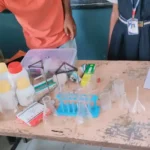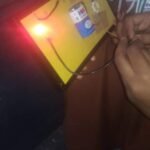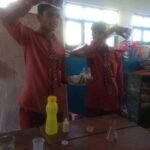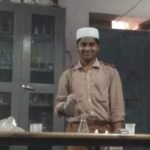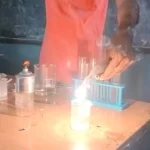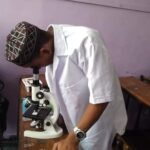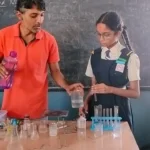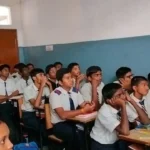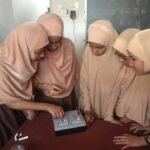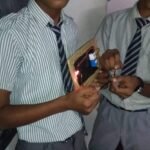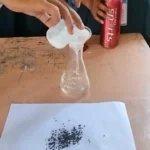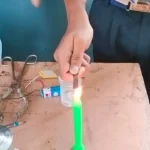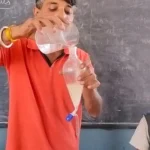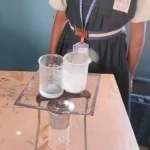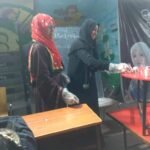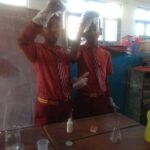Erudite Labs
List of Class 10 Lab Activities
Class 10 Physical Science:
Session – 1:
Chapter 1: Reflection of light at curved surfaces
- Explanation on reflection of light.
- Plane Mirror
- Spherical mirrors
- Concave
- Convex
- Rule of Plane mirror using laser
- Rules of Concave mirror using laser
- Rules of Concave mirror using laser
- Finding the focal length of unknown spherical mirror
- Solar cooker model
Chapter 4: Refraction of Light at Curved Surfaces
- Explanation on refraction of light.
- Plane glass slab
- Lenses
- Concave
- Convex
- Rule of refraction through glass slab using laser
- Rarer to denser medium
- Denser to rarer medium
- Rules of Concave lens using laser
- Rules of Convex lens using laser
- Finding the focal length of unknown lens
- Focal length of lens
- Depends on curvature of lens
- Medium surrounding the lens
- Combination of lenses
Session – 2:
Chapter 2: Chemical Equations
- Reaction of Calcium oxide with water
- Reaction of sodium sulfate and barium chloride.
- Reaction of hydrochloric acid to the zinc granules
- Mole concept with an activity.
Chapter 3: Acids, Bases and Salts
- Acid bases test with Natural indicators
- Acid bases test with artificial indicators
- Reaction of Acid with metals
- Reaction of Acid with metal carbonates and Bicarbonate.
- Reaction of Acid with Bases
- Reaction of Acid with metals oxides
- Reaction of Bases with metals
- Reaction of Bases with Nonmetals oxide
- Electrical conductivity of
- Acids
- Bases
- Salts
- Reaction of Salt with Acids
- Preparation of Hcl gas
- pH of mouth and Soil
- Electrolysis of Brine
- Identification test of baking soda and washing soda
- water of crystallization
Session – 3:
Chapter 5: Human Eye the colorful world
- Structure of Human Eye using plastic model
- Least distance of distinct Vision
- Angle of Vision of Normal Eye
- Eye Defects and Correction.
- Myopia
- Hypermetropia
- Presbiopia
- Combination of lenses
- Concave and convex
- Concave and concave
- Convex and convex
- Finding the refractive index of a prism.
- Dispersion of light using
- Prism
- Water Tub activity
- Scattering of light
Chapter 8: Chemical Bonding
- Explanation Structure and bonding in molecules using plastic models
- Beryllium chloride
- Boron trifluoride
- Ammonia
- Methane
- Water
- Nitrogen
- Oxygen
- Fluorine
- Lenses
Chapter 8: Carbon and its Compounds
- Esterification reaction.
- Saponification reaction (Preparation of Soap)
Session – 4:
Chapter 9: Electricity
- Components of electric circuit and their role in circuit
- Parallel Circuits of
- Bulbs
- Resistors
- Batteries
- Parallel Circuits of
- Bulbs
- Resistors
- Batteries
- Ohm’s Law and verification
- Resistance of Conductor Varies with
- Length
- Area of cross section
- Nature of material
- Temperature
- Kirchhoff’s laws
- Junction Law
- Loop’s law
- Household devices in parallel and series circuits
Chapter 10: Magnetism
- Oersted experiment
- Magnetic field around
- Bar magnet
- Disc Magnet
- HorseShoe shaped Magnet
- Lines of magnetic field around Current carrying conductor.
- Linear
- Loop
- Solenoid
- Magnetic field due to straight wire carrying current
- Magnetic field due to wire loop carrying current
- Magnetic field due to solenoid carrying current
- Force applied on a current carrying wire by an Magnet
- Simple Electric Motor
- Simple Electric generator
- Magnetic Levitation
- Faraday’s induction in a loop
Class 10 Biological Science:
Session – 1:
Chapter 1: Nutrition
- Priestley’s model experiment.
- Hydrilla plant experiment.
- Mohl’s half leaf experiment.
- Presence of starch in plants.
- T.S of leaf under microscope.
- Structure of chloroplast using a plastic model.
- Explanation on digestive system with digestive system plastic model. (Hen Digestive system – Dissection can be arranged only with special interest)
- Peristaltic movement
Chapter 2: Respiration:
- Explanation on Respiration with the respiratory system plastic model. (Goat lungs – Dissection can be arranged only with special interest)
- Liberation of CO2 during respiration.
- Rate of respiration depends on metabolic activities.
- Total lung capacity using goat lung.
- Structure of mitochondria using a plastic model.
- By-Product of respiration by Charing Sugar.
- Evolution of CO2 during respiration.
- Evolution of Heat during respiration.
Session – 2:
Chapter 3: Circulatory system
- Pulse Rate.
- Heart Beat varies with metabolic activity.
- Structure of Heart with the Heart plastic model.
(Goat Heart – Dissection can be arranged only with special interest)
- Circulatory system with the plastic model.
- Blood Pressure by sphygmomanometer.
- Blood Groups
- Root pressure activity.
- Transpiration activity
Chapter 2: Excretory System
- Explanation on Excretory system with the Excretory system plastic model.
- T.S of Kidney with the Kidney plastic model. (Goat Kidney – Dissection can be arranged only with special interest)
- Explanation on Nephron with the Nephron plastic model.
- Presence of Urea in urine.
Session – 3:
Chapter 5: Nervous system
- Structure of Neurons using Plastic model.
- Structure of the Brain using a plastic model.
- Explanation on Brain lobes using plastic models. (Goat Brain – Dissection can be arranged only with special interest)
- Went Experiment
Chapter 6: Reproductive System
- Bacterial colony in milk and Curd under microscope
- Fission under microscope
- Budding under microscope
- Fragmentation under microscope
- Natural Vegetative propagation in Bryophyllum plants
- Artificial Vegetative propagation
- Cutting
- Layering
- Grafting
- Rhizopus or common mold under the microscope
- Explanation on Male reproductive system using a plastic model.
- Explanation on Female reproductive system using a plastic model.
- Parts of a flower
- Pollen grain under microscope
- Structure of ovule using a plastic model.
- Plant and animal cell under microscope.
- Mitosis under microscope
Session – 4:
Chapter 7: coordination
- Structure of buccal cavity
- Dental arrangement using plastic model
- pH of mouth
- Action of saliva on flour
- Peristaltic movement
- Role of mucus secretion in the gut.
- Priestley’s model experiment.
- Hydrilla plant experiment.
- Mohl’s half leaf experiment.
- Presence of starch in plants.
- T.S of leaf under microscope.
- Structure of a villus under Microscope.
Chapter 8: Heredity:
- Explanation Mendel’s phenotype and genotype with activity and charts.
- Explanation of Monohybrid cross with activity and charts.
- Explanation of Dihybrid cross with activity and charts.
========================================
========================================
Class Wise Activities Brochure

Demo Registration Form
